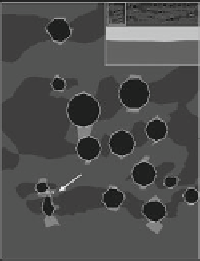Information Technology Reference
In-Depth Information
(a)
(b)
50
40
30
20
10
0
-10
-20
theor.
bubbles
-30
-40
-50
0,0
0,2
0,4
0,6
0,8
1,0
1,2
y [mm]
Fig. 9.14 The thermal stress in a wet enameling coating. a The stress along with a transversal
section b a detail of the stress near the bubbles
Fig. 9.15 Residual stress for
a coating manufactured with
the dry enameling technique
enameling manufacture processing. It was expected, since a difference between the
thermal expansion coefficient of the two coating systems exists.
Figure
9.16
a reports the thermal stress along with a vertical cross-section
through the coating, relative to X/l = 0.5, while in Fig.
9.16
b a detail of Fig.
9.15
is shown, where the zone of the maximum stress measured in the coating is
evidenced.
The trend of the stresses is similar to that reported for the previous coating
analyzed, and the scattering of the values in the coating is noticeable with respect
to the linear trend of a theoretical coating devoid of bubbles.
A further analysis was conducted by taking into account the graded layer
between the coating and the substrate. The graded layer was introduced in the
models by interposing two slight layers with a thickness of 0.010 mm and linearly
variable mechanical and thermal properties between the two constituents. The
thickness of the graded layer was derived from measurements on images of higher


























































Search WWH ::

Custom Search